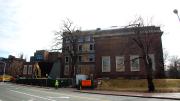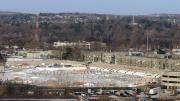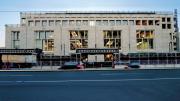Renovation of the Fogg Art Museum complex at 32 Quincy Street got a green light this spring, signaling the beginning of a new phase for University projects in Cambridge that focus on repurposing space on existing sites. Meanwhile, the last of Harvard’s new construction wound down as the Law School’s Northwest Corner building began to take shape.
At the museum complex, interior demolition continued through March and into April. A small bulldozer could be seen pushing debris from a cavernous hole (in the side of the building facing Broadway) down into a waiting dumpster. As of the end of March, 87 percent of the construction debris had been recycled. The designers hope that when complete, the complex will rate a gold LEED certification. (LEED, or Leadership in Energy and Environmental Design, is a series of standards for sustainable structures set by the U.S. Green Building Council, a nonprofit building-industry consortium.)
When it concludes in 2013, the museum project will unite in one facility the Busch-Reisinger (where the roof was leaking) with the collections, galleries, and curatorial staff of the Fogg and the Sackler.
Students, faculty, scholars, and the public will have significantly greater access to the collections, not only through larger exhibition galleries, but through new, expanded study centers that will become a hallmark of the new museum. The new Harvard Art Museum will also combine within its renovated space--and 100,000 gross square feet of new construction--ample room for conservation labs, and classrooms. Climate control to preserve the artworks that Harvard owns and those it hosts as part of traveling exhibitions will be a major step forward for collection care. Security systems will also be upgraded.
Under the careful guidance of Pritzker Prize-winning architect Renzo Piano (who is simultaneously working on a new wing for the Isabella Stewart Gardner Museum in Boston), the museum’s original central courtyard will be restored. Staging for that phase of the renovation began in April.
The green emphasis of the art museum project continues at the Law School’s Northwest Corner building, which is also expected to receive LEED gold certification when completed in December 2011. That 250,000-square-foot building will include a garage with space for 695 cars (with the better spaces reserved for environmentally friendly vehicles), an academic center named Wasserstein Hall, space for student organizations and activities in the Caspersen Student Center, and a wing that will house the school’s clinical legal programs.
Meanwhile, the University is pursuing a two-pronged strategy to develop and maintain its real-estate holdings across the Charles River in Allston. The nonprofit Earthwatch Institute will occupy 15,000 square feet of space in the building at 114 Western Avenue, formerly a WGBH facility; additional partnerships are being sought to co-develop other vacant property.











